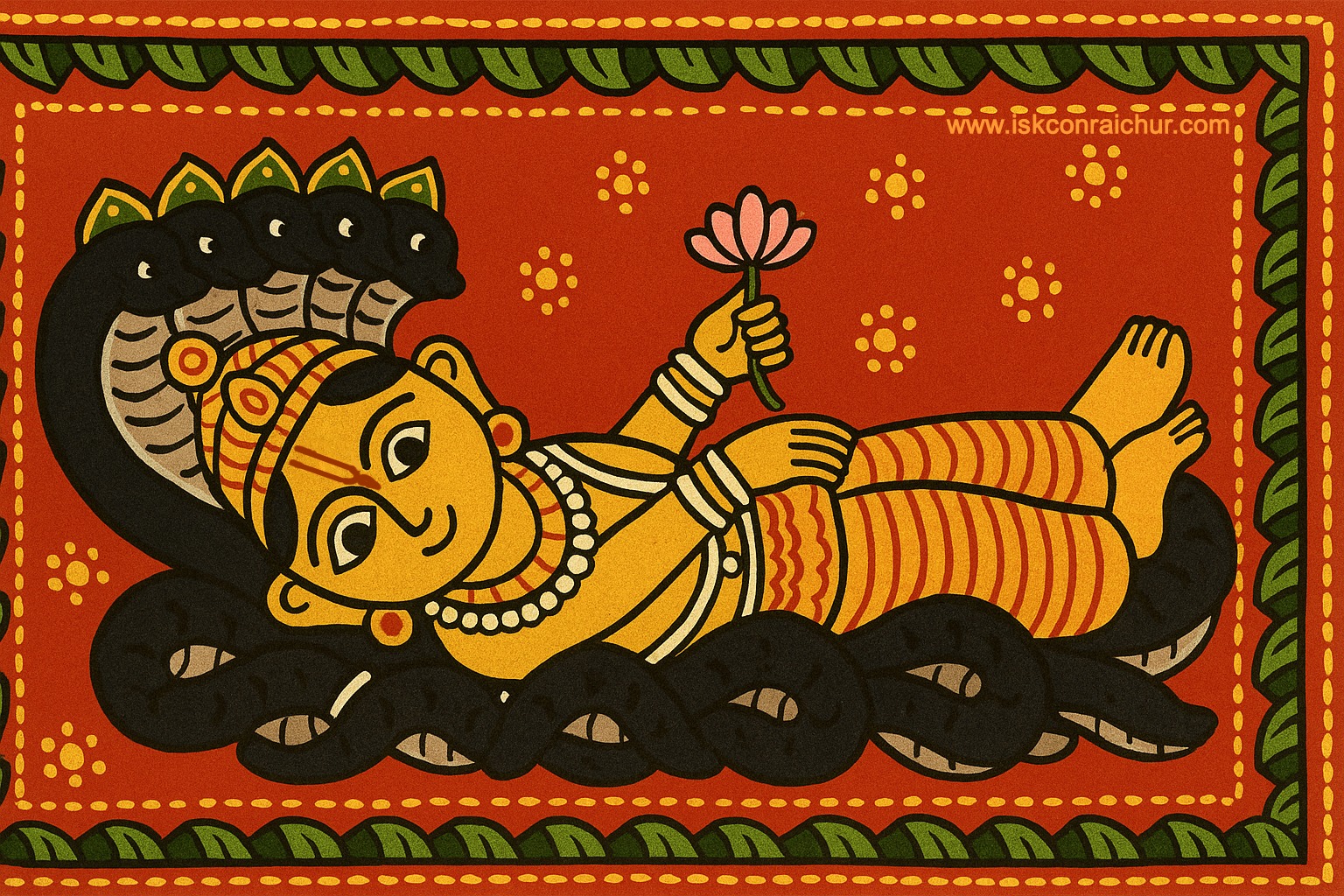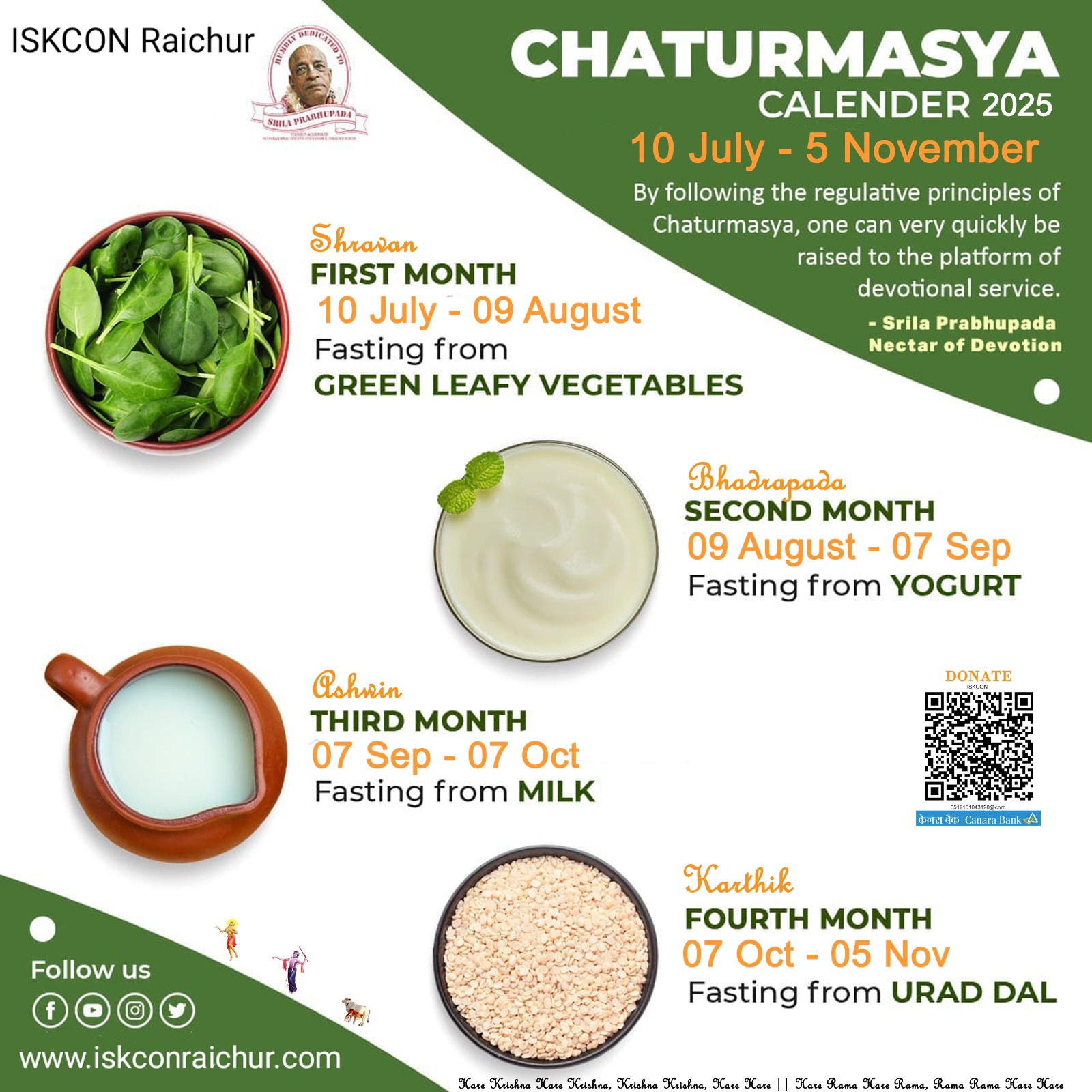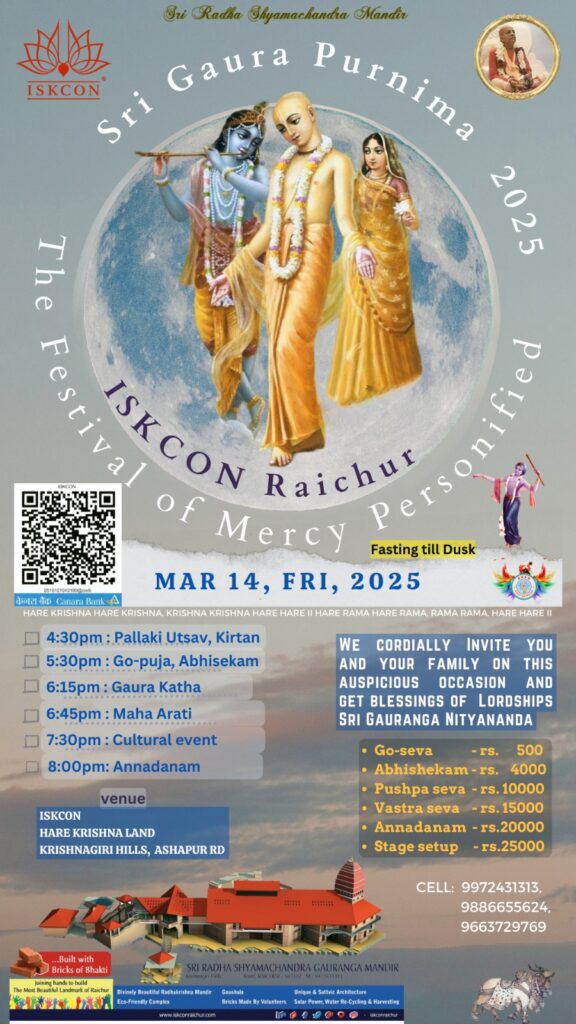

What is Chaturmasya Vrata?
Chaturmasya is a Sanskrit term where “Chatur” means four, “Masya” means months, and “Vrata” means austerity or vow. The Chaturmasya Vrata is a sacred observance spanning four holy months, starting the day after Deva Sayana Ekadashi in the Ashada month (June–July) and ending on Uthana Ekadashi in the Kartik month (October–November).
Some traditions, including ISKCON, observe Chaturmasya from the Full Moon day of Ashada to the Full Moon day of Kartik.
During this time, Lord Vishnu is believed to enter a divine sleep in the Ksheer Sagar (Ocean of Milk) resting on Sheshanaga (Ananta Shesha). This marks Sayana Ekadashi. He awakens after four months on Uthana Ekadashi.
Who Can Observe Chaturmasya Vrata?
Anyone can observe this Vrata, regardless of:
- Ashram: Brahmachari, Grihastha, Vanaprastha, or Sannyasi
- Varna: Brahmana, Kshatriya, Vaishya, or Shudra
It is a universal vrata meant for all seeking spiritual upliftment.
The Four Sacred Months & Their Austerities
1️⃣ Sravana Month – Fasting from Green Leafy Vegetables
Known as Shaka Vrata
Avoid: Spinach, Coriander, Fenugreek, Mint, Curry leaves, etc.
2️⃣ Bhadrapada Month – Fasting from Yogurt (Curd)
Known as Dadhi Vrata
3️⃣ Ashwin Month – Fasting from Milk
Known as Ksheera Vrata
4️⃣ Kartik Month – Fasting from Urad Dal (Black Gram)
Known as Dwidala Vrata
Benedictions of Observing Chaturmasya
The purpose of Chaturmasya Vrata is to minimize sense gratification and maximize spiritual engagement. It is said:
- Austerities performed during this time yield multiplied spiritual benefits.
- One who observes Chaturmasya is blessed with purity and elevated consciousness.
- Vaishnavas particularly benefit through chanting, prayer, and service during this time.
Seva: Spiritual Services & Their Benefits (As per Padma Purana)
- Temple Cleaning: Ensures enjoyment for seven births.
- Abhisheka to the Lord (Milk, Curd, Ghee, Honey, Sugar): Leads to heavenly pleasures.
- Donation of 28 or 108 earthen pots with Tila: Frees one from all sins.
- Singing Devotional Songs: Attains Gandharva Loka.
- Circumambulating the Temple: Grants entry to the abode of Krishna.
- Renouncing Jaggery: Blessings of offspring.
- Not Observing Vrata: Considered spiritually dead, despite being alive.
Tapasya: Spiritual Disciplines to Follow
- Wake up before sunrise and take a bath.
- Chant during early morning hours.
- Increase your number of japa rounds.
- Observe Celibacy for four months.
- Donate as per your capacity.
- Read and meditate on:
- Gajendra Moksha Lila
- Prayers of Kunti Devi
- Gopi Geet
- Bala Lila from Krishna Book
- Srimad Bhagavatam & Bhagavad Gita
- Strictly observe the eight Ekadashis during these months.
- Worship Tulasi Devi, offer leaves, and do Parikrama.
- Engage in Vaishnava Seva: Invite for prasadam, chant together.
- Read one book of Srila Prabhupada.
- Sing Vaishnava Bhajans with meaning.
- Visit holy places (Tirtha Yatra).
- Serve and promote Krishna Consciousness.
- Pray to Lord Krishna daily before sleeping.
Niyamas: Rules & Regulations
- Do not break the Four Regulative Principles:
- No meat eating
- No gambling
- No intoxication
- No illicit sex
- Do not criticize others.
- Avoid sleeping on the bed — sleep on the floor with proper bedding.
- Avoid excessive sleep.
- Avoid auspicious events like weddings or purchasing land during Chaturmasya.
Stories from Chaturmasya Vrata
1. Narada Muni and the Transformation of a Shudra Boy
Once, Narada Muni explained to Vyasadeva how Chaturmasya transformed a lowly-born Shudra boy into a great saint. This boy, born to a maidservant, lacked social respect. During Chaturmasya, exalted sages visited his home. The boy served them humbly, heard scriptures while eating their remnants (ucchishta), and upon his mother’s passing, traveled in search of truth. Eventually, he was blessed by Lord Vishnu and became none other than Devarshi Narada himself.
2. Sri Chaitanya Mahaprabhu’s Observance of Chaturmasya
“ei-mata mahāprabhu bhakta-gaṇa-saṅge cāturmāsya goṅāilā kṛṣṇa-kathā-raṅge”
“Śrī Caitanya Mahāprabhu spent the entire period of Cāturmāsya in the joy of discussing Kṛṣṇa-kathā with His devotees.”
(CC Antya 10.133)
During His South Indian tour, Sri Chaitanya Mahaprabhu took bath in the Kaveri River and had darshan of Sri Ranganatha Swamy. A devout Sri Vaishnava, Venkat Bhat, invited the Lord to his home, saying, “If You stay just one minute in our house, we will be liberated.” Mahaprabhu stayed for four months, and every day was filled with kirtan, katha, and spiritual bliss. Unlike today, where devotees find it hard to spare even a Sunday, back then, no one worked during Chaturmasya – they only engaged in Krishna consciousness. During this time, Gopal Bhatta Goswami was blessed to manifest Sri Radha Ramanji from a Shaligrama shila.
3. Famous Festivals During Chaturmasya
Chaturmasya encompasses many auspicious festivals:
- Guru Purnima (Vyasa Purnima)
- Sanatana Goswami Disappearance Day
- Balaram Jayanti
- Sri Krishna Janmashtami
- Radhashtami
- Vamana Jayanti
- Govardhan Puja
- Kartik Navaratri
- Deepavali
4. The Glories of Origin of Chaturmasya in the Varaha Purana
The Varaha Purana describes a deep and touching conversation between Dharani Devi (Mother Earth) and Lord Varaha, revealing the profound significance of Chaturmasya, especially for the people of Kali Yuga.
Concern of Dharani Devi
Once, Dharani Devi, deeply worried about the condition of people in Kali Yuga—who are ignorant, short-lived, and constantly afflicted with ailments—approached Lord Varaha and humbly pleaded:
“O Lord, is there a way that even such fallen souls in Kali Yuga can attain great spiritual merit with minimal effort?”
Lord Varaha’s Reply
Smiling compassionately, Lord Varaha answered:
ಅಸ್ತಿ ಪ್ರಿಯತಮಃ ಕಾಲಃ
ಚಾತುರ್ಮಾಸ್ಯಾಭಿಧೋ ಮಾಮ್ ।
ಪಠಣ ದಾನಂ ವ್ರತಂ ಜಪೋ ಹೋಮಃ
ತತ್ರಾನಂತಗುಣಂ ಸ್ಮೃತಮ್ ॥ ವರಾಹ 1.16
“Indeed, there is a most beloved time known as Chaturmasya. Any act of study (pathana), charity (dana), vow (vrata), chanting (japa), or sacrifice (homa) performed during this period yields immeasurable merit.”
ಮಾಸೇಷ್ವಾನ್ಯೇಷು ಯತ್ಕಿಂಚಿತ್
ಕ್ರಿಯತೇ ಮಾಮ್ ತೋಷನಮ್ ।
ತತೋಪ್ಯಾನನ್ತ್ಗುಣಿತಂ
ಚಾತುರ್ಮಾಸ್ಯೇ ನ ಸಂಶಯಃ ॥ ವರಾಹ 1.17
“Any act done for My pleasure in other months becomes infinitely more fruitful during Chaturmasya—there is no doubt about this.”
The Cosmic Explanation
Dharani Devi then asked, “Why are only these four months so spiritually significant out of the twelve?”
Lord Varaha explained:
- A human year is equivalent to one full day and night for the celestial beings (Devas).
- The six months from Ashadha to Pushya are the night (Dakshinayana) for the Devas, while the rest are the day (Uttarayana).
- During the Dakshinayana period, when the night for the Devas begins, a lady dark in complexion came to Meru Mountain where Lord Varaha was seated.
- She wore sparkling white clothes, held a parashu (axe), and introduced herself as Ratri Devi, the presiding deity of the night.
The Plea of Ratri Devi
Ratri Devi, feeling rejected and unloved by humans because no auspicious activities like marriages take place during her reign, said:
“Everyone considers me inauspicious. I no longer wish to exist. Please give me a reason to live, O Lord.”
Moved by her plea, the Devas also interceded, requesting Lord Varaha to grant her some significance.
The Divine Boon
Lord Varaha blessed her:
“O Ratri, you shall have three Yamas (one Yama = 2 months). The first two Yamas (four months of Chaturmasya) will become most beloved to Me. Any spiritual activity performed during this time will bear immense fruit. The merit accrued will increase day by day, making Kartik month the most glorious of all.”
Hearing this, Ratri Devi was overjoyed and returned to her celestial abode, uplifted and honored.
🌟 Moral of the Story
Even in dark times (symbolized by Ratri or Kali Yuga), divine grace can be attained through faith and spiritual effort. The Lord’s compassion knows no bounds. Chaturmasya is a powerful opportunity to reconnect, purify, and uplift our consciousness—even with the simplest of efforts.
Who Can Perform Chaturmasya Vrata?
- All living beings – men, women, young, old
- Followers of all varnas: Brahmana, Kshatriya, Vaishya, Shudra
- All ashramas: Brahmachari, Grihastha, Vanaprastha, Sannyasi
- Women, including during menstruation
As per Bhavishya Purana, those who do not observe Chaturmasya are considered like the living dead.
Scientific & Ayurvedic Reasons for Food Restrictions
During monsoon and early winter:
- Digestion slows down
- Immunity drops
- Dominance of Tamo Guna increases
- Risk of vomiting, diarrhea, uterine issues, and bacterial infections
Hence, avoiding certain foods and increasing Satva Guna through fasting, chanting, and celebrating festivals is encouraged.
Restricted Foods & Their Spiritual Benefits
| Restriction | Spiritual Benefit |
|---|---|
| No salt | Voice becomes sweet |
| No oil | Long life and progeny |
| No massages | Body becomes beautiful |
| No cooking in oil | Enemies are destroyed |
| No licorice/oil | Becomes wealthy |
| No unoffered flowers | Becomes Vidyadhara in Devapura |
| No 6 tastes | Avoids ugliness and bad births |
| No betel nuts | Becomes joyful |
| No cooked food | Attains purity |
| No milk or curd | Attains Goloka |
| No hot food | Offspring with long life |
| No intoxicants | Becomes powerful |
| Sleep on floor | Becomes associate of Lord Vishnu |
| Chanting “Namo Narayana” | Benefit equal to 100 dana |
| Clean the temple | Remains king for a kalpa |
| Study Sastras | Attains Vishnuloka |
| Worship Lord with flowers | Goes to Vaikuntha |
These austerities are referenced from Vishnu Rahasya and other Puranas.
Chaturmasya Sankalpa Mantras
Chaturmasya Sankalpa Mantra (Initiation Verse)
Sankalpa Mantra
Vrataanaam vakshyamaanaanaam sankalpam vidhivat charet |
Naimittikaanaam kaamyaanaam nityaanaam cha tathaiva cha ||Shaka Vrata (Leafy Greens)
Shaakavratam mayaadeva gruhitam puratastava |
Nirvignam siddhimaayaatu prasaadaat tava Keshava ||
Dadhi Vrata (Curd)
Dadhi bhaadrapade maasi varjayishye sadaa hare |
Imam karishye niyamam nirvignam kuru Keshava ||Ksheera Vrata (Milk)
Kshiravratamidam deva gruhitam puratastava |
Nirvignam siddhimaayaatu prasaadaat Ramaapate ||Dvitala Vrata (Urad Dal)
Kaartike dvidalam dhaanyam varjayishye sadaa hare|
Imam karishye niyamam nirvignam kuru Keshava ||Purna Samarpana (Final Offering after Kartik Ekadashi)
After completing the four vratas, on Kartik Shukla Ekadashi, one should offer:
- Dwidala grains
- Fruits and vegetables
- Dakshina to a qualified Brahmana
Final prayer:
Aniruddha namastubhyam dvidalaakyavratena cha |
Matkrutenaashvine maasi prityartham phalado bhava ||
Idam vratam mayaa deva krutam prityai tava prabho |
Nyunam sampurnataam yaatu tvatprasaadaat janaardhana||
Deva deva, jagannatha, lakshmi damodara prabho.
Chaturmasye tvayajnaptah, krutva vrata chatushtayam|
Bhavannmurtim pradasyami tvat prasadabhikankshaya||Conclusion
Observing Chaturmasya Vrata elevates one’s spiritual consciousness, brings health and harmony, and attracts the mercy of Lord Vishnu. Even small efforts, when done sincerely during these four sacred months, carry immense spiritual merit.


